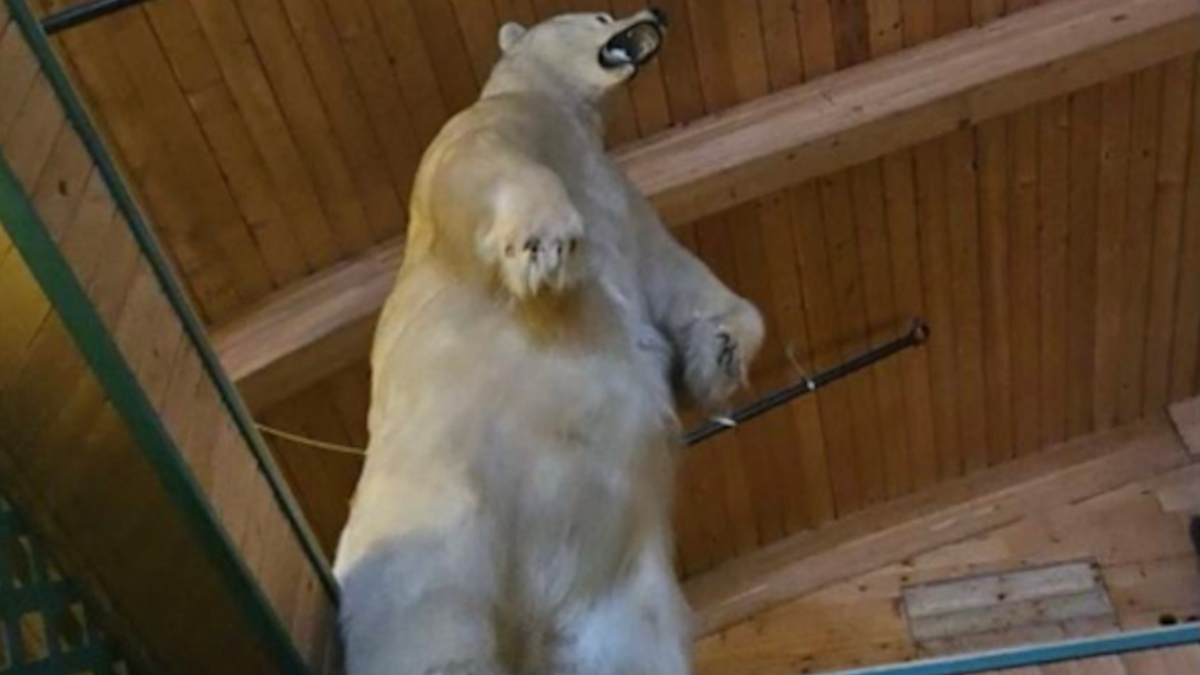
Harry left the old Alberta resort just like he arrived: shrouded in mystery.
The 12-foot, 500-pound taxidermied polar bear, known as Harry, was stolen last month from the facility just north of Edmonton, and police are asking for the public’s help in identifying the perpetrators.
“It’s just so bizarre right?” Wanda Rowe told the St. Albert Gazette. Rowe is the executive director of Lionsheart Wholeness Centre, where Harry used to live. “For us initially it was emotional, because it’s been here for so long. We also felt violated that someone could come in and just take this.”
Rowe believes the heist went down during a cold snap in mid-January. The facility is usually monitored by security personnel, but those patrols were canceled due to the extreme cold. She says the thieves entered the empty building and cut the cables holding the bear. They dragged it across the balcony where Harry normally stood, down the stairs, and out the front double doors. They then loaded it into a truck and drove away.
Rowe claims it took her several days to realize the bear was missing and file a police report.
Harry isn’t the only creature to be taxi-napped from the retreat center. Last summer, two raccoons disappeared from the property and still haven’t been located.
Alberta RCMP Constable Kelsey Davidge is asking the public to keep an eye out for Harry on online marketplaces. “That would stick out right away, if you saw that anywhere, right?” she asked. She’s dubbed this case “The Heist of the Big Polar Bear,” according to the Gazette.
Harry’s origins are unclear. The resort center has changed hands several times over the last few decades, but at one point, it was known as Lily Lake Resort and had a bar called Harry’s, named in honor of the bruin.
Polar bear hunting in the U.S., Canada, and the Soviet Union was largely unregulated until the mid-20th century. That changed in the 1970's, and today Alaska does not allow non-native people to hunt polar bears, and the meat and hide cannot be sold.
Canada is the last remaining region in the polar bear’s range where the export of polar bear skins and trophies is legal, but hunting is strictly regulated. Tags are given exclusively to indigenous people groups, but in Nunavut and the Northwest Territories of Canada, indigenous people may choose to fill part of their quota by offering a guided hunt to non-indigenous people, according to Nunavut’s Department of Environment.
A non-indigenous hunter must purchase a tag, hire a local guide, and pursue a polar bear using traditional methods, including dog sled teams. Much like when hunting in Africa, the meat is then given back to the local community.
A researcher told National Geographic that having a polar bear skin is the “ultimate status symbol…It’s like to have a Ferrari car in your garage.” A yellowed taxidermied bear may not elicit quite the same reaction, but the Gazette reports that the raccoons and bear together could fetch as much as $35,000.
Feature image via Alberta Proud Facebook Page.





